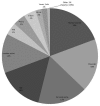Knowledge and pre-thoracic spinal thrust manipulation examination: a survey of current practice in the UK
- PMID: 30455557
- PMCID: PMC6237157
- DOI: 10.1080/10669817.2018.1507269
Knowledge and pre-thoracic spinal thrust manipulation examination: a survey of current practice in the UK
Abstract
Objectives: The perceived relative safety of thoracic thrust joint manipulation (TTJM) has contributed to evidence supporting its use. Yet, TTJM is not without risk, where transient side effects (SE) and severe adverse events (AE) have been documented. With evidence supporting the importance of prethrust examination in reducing AE in other spinal regions this study investigated TTJM knowledge and pre-TTJM examination. Method: An e-survey, informed by existing evidence and expertise was designed and piloted. Eligibility criteria: UK-trained physiotherapists who use TTJM. Recruitment via professional networks and social media from December 2016 to February 2017. Data analysis included descriptive analyses (means, standard deviation and frequencies/central tendencies), and content analysis (themes and frequencies) for free text data. Results: From 306 responses, the sample comprised 146 (53%) males, mean (SD) age 36.37(8.68) years, with 12.88(8.67) years in practice, 11.07(8.14) years specialization, working in National Health Service/private practice (81%) and performing 0-5 TTJM/week (86%).
Examination: 40% (n = 83) utilized pre-TTJM examination with 45% (n = 139) adapting the examination for different regions. Technique selection and effect: preferred technique was prone rotational TTJM (67%). Perception of the primary underlying effect was neurophysiological (54%), biomechanical (45%) or placebo (1%). Knowledge: Levels of agreement were found for contraindications (85%), precautions (75%), and red flags (86%) with more variability for risks including AE and SE (61%).
Discussion: UK physiotherapists demonstrated good knowledge and agreement of contraindications, precautions, and red flags to TTJM. With <50% respondents utilizing pre-TTJM examination, variable knowledge of TTJM risks, and therapeutic effects of TTJM further research is required.
Keywords: Examination; clinical knowledge; current practice; survey; thoracic; thrust manipulation.
Figures
Similar articles
-
Thoracic thrust joint manipulation: An international survey of current practice and knowledge in IFOMPT member countries.Musculoskelet Sci Pract. 2020 Dec;50:102251. doi: 10.1016/j.msksp.2020.102251. Epub 2020 Sep 8. Musculoskelet Sci Pract. 2020. PMID: 32992076
-
[Standard technical specifications for methacholine chloride (Methacholine) bronchial challenge test (2023)].Zhonghua Jie He He Hu Xi Za Zhi. 2024 Feb 12;47(2):101-119. doi: 10.3760/cma.j.cn112147-20231019-00247. Zhonghua Jie He He Hu Xi Za Zhi. 2024. PMID: 38309959 Chinese.
-
Safety of thrust joint manipulation in the thoracic spine: a systematic review.J Man Manip Ther. 2015 Jul;23(3):154-61. doi: 10.1179/2042618615Y.0000000012. J Man Manip Ther. 2015. PMID: 26309386 Free PMC article.
-
Spinal manipulation and adverse event reporting in the pregnant patient limits estimation of relative risk: a narrative review.J Man Manip Ther. 2023 Jun;31(3):162-173. doi: 10.1080/10669817.2022.2118653. Epub 2022 Sep 1. J Man Manip Ther. 2023. PMID: 36047253 Free PMC article. Review.
-
A systematic review of thrust manipulation for non-surgical shoulder conditions.Chiropr Man Therap. 2017 Jan 4;25:1. doi: 10.1186/s12998-016-0133-8. eCollection 2017. Chiropr Man Therap. 2017. PMID: 28070268 Free PMC article. Review.
Cited by
-
Definition and classification for adverse events following spinal and peripheral joint manipulation and mobilization: A scoping review.PLoS One. 2022 Jul 15;17(7):e0270671. doi: 10.1371/journal.pone.0270671. eCollection 2022. PLoS One. 2022. PMID: 35839253 Free PMC article.
-
Thoracic adverse events following spinal manipulative therapy: a systematic review and narrative synthesis.J Man Manip Ther. 2020 Dec;28(5):275-286. doi: 10.1080/10669817.2020.1725277. Epub 2020 Mar 9. J Man Manip Ther. 2020. PMID: 32148185 Free PMC article.
-
Reporting of adverse events associated with spinal manipulation in randomised clinical trials: an updated systematic review.BMJ Open. 2023 May 4;13(5):e067526. doi: 10.1136/bmjopen-2022-067526. BMJ Open. 2023. PMID: 37142321 Free PMC article.
References
-
- Adams G, Sim J.. A survey of UK manual therapists’ practice of and attitudes towards manipulation and its complications. Physiother Res Int. 1998;3(3):206–227. - PubMed
-
- Puentedura E, Landers M, Cleland J, et al. Thoracic spine thrust manipulation versus cervical spine thrust manipulation inpatients with acute neck pain: a randomized clinical trial. J Orthop Sports Phys Ther. 2011;41(4):208–220. - PubMed
LinkOut - more resources
Full Text Sources


